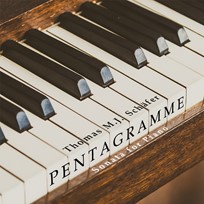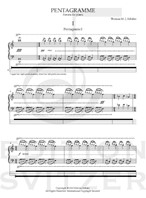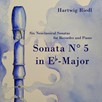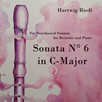
Pentagramme
Composer: Thomas Schäfer
Instrument: Piano
Level: Advanced
Published: 2022
Price: €25.00
Item details
-
Description +
-
Duration: 15-16 min.
The classical cyclic sonata form combined with the possibilities of the 20th century – that is the intention of the piano sonata “Pentagrams”. The number 5 is the main focus with the exploration of its technical and tonal possibilities on the piano. In the three movements, different motifs take up that number in different shapes and compete in constantly developing variations.
The first movement Pentagrams I is characterised by the contrasting and developing of several related motifs which make up a free sonata form. In the process, tonality doesn’t necessarily refer to the root note but to the target notes. The completeness of the twelve chromatic tone steps plays a major role for the individual parts which can’t be completed without a “resolution” – which here means a completion of the 12 semitones.
Dodecaphony also rules in the second, lyrical movement Carillon. The Carillon motif is taken from the first movement and becomes independent. It is followed by a twelve-tone row which will develop to a cantabile miniature. These elements are framed by the bell sounds of the Carillon in a rondo-like way, which itself then turns into a twelve-tone row and erupts in a dodecaphonic permutation fugue.
The final movement Pentagrams II is at the same time a movement consisting of variations and a rondo, whereby the idea of mirroring is carried to its extremes. The entire movement is mirrored along a centre axis. The Carillon motif is the base of the centre of the final presto, thereby creating a cyclic arch over all three movements.
-
-
Instrumentation +
-
Piano
-
-
About the composer +
-
The composer and conductor Thomas Martin Johannes Schäfer draws his tonal language from all styles and forms of the last millennium and tries to create a new tonal language in this way. For him, composition is both improvisation and construction, cognitive play with the possibilities as well as impulsiveness and intuition. He defines his musical language as postmodern.
Thomas M. J. Schäfer was born in 1979 in Schwäbisch Gmünd, Southern Germany. He completed his studies at the music academies in Stuttgart with Prof. Jon Laukvik and in Munich with Prof. Bruno Weil and graduated in 2008 with a master class diploma in orchestral conducting. He led numerous orchestras, including the Munich Symphony Orchestra, was choir director of the Junge Oper at the Staatsoper Stuttgart, where he also took part in world premieres such as Randolphs Erben by Ruedi Häusermann. Since 2008 he is responsive as the main church musician at St. Josef Böbingen, he works as an organist and piano accompanist and teaches at the Baden-Württemberg Landesgymnasium in Schwäbisch Gmünd. After having co-initiated the youth symphony orchestra Junge Gmünder Symphoniker, he had the honour of conducting the foundation concert.
His works have received international acclaim and have been performed in many countries, for example at the Israel Philharmonic Orchestra's gala dinner in honor of Zubin Mehta in Tel Aviv. For his composition Exultet – Easter Light Thanksgiving, Thomas M. J. Schäfer received personal thanks and recognition from the dedicatee Pope Emeritus Benedict XVI.
Thomas M. J. Schäfer premiered numerous of his compositions and arrangements with his choirs and orchestras. The Clarinet Concerto Impressions – Concertant Fantasy for Clarinet and Orchestra was awarded second prize at the composition contest of the German Federal Music Festival in 2001, another prize followed in 2018 for the riddle canon JSBach 333.
-
-
Credits +
-
Front Cover graphics and layout: Nicola Lee
Photo: KD Busch
Engraving: Ary Golomb
Printed in Copenhagen, Denmark
Copyright © Edition SVITZER
www.editionsvitzer.com
-










